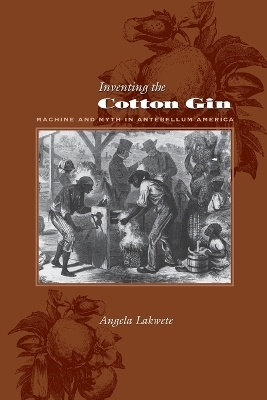
Inventing the Cotton Gin
Machine and Myth in Antebellum America
Seiten
2005
Johns Hopkins University Press (Verlag)
978-0-8018-8272-2 (ISBN)
Johns Hopkins University Press (Verlag)
978-0-8018-8272-2 (ISBN)
- Lieferbar (Termin unbekannt)
- Versandkostenfrei innerhalb Deutschlands
- Auch auf Rechnung
- Verfügbarkeit in der Filiale vor Ort prüfen
- Artikel merken
"The cotton gin animates the American imagination in unique ways. It evokes no images of antique machinery or fluffy fiber but rather scenes of victimized slaves and battlefield dead. It provokes the suspicion that had Eli Whitney never invented the gin, United States history would have been somehow different. Yet cotton gins existed for centuries before Whitney invented his gin in 1794. Nineteenth-century scholars overlooked them as well as gins made by southern-and northern-mechanics, in order to create a history meant to chasten some southerners and demean others. Using the gin as evidence, they read failure back from the Civil War into the choices that southerners made from the American Revolution, tracing the steps that led them to Appomattox." In Inventing the Cotton Gin, Lakwete explores the history of the cotton gin as an aspect of global history and an artifact of southern industrial development. She examines gin invention and innovation in Asia and Africa from the earliest evidence to the seventeenth century, when British colonizers introduced an Asian hand-cranked roller gin to the Americas.
Lakwete shows how indentured British, and later enslaved Africans, built and used foot-powered models to process the cotton they grew for export. After Eli Whitney patented his wire-toothed gin, southern mechanics transformed it into the saw gin, offering stiff competition to northern manufacturers. Far from being a record of southern failure, Lakwete concludes, the cotton gin-correctly understood-supplies evidence that the slave labor-based antebellum South innovated, industrialized, and modernized.
Lakwete shows how indentured British, and later enslaved Africans, built and used foot-powered models to process the cotton they grew for export. After Eli Whitney patented his wire-toothed gin, southern mechanics transformed it into the saw gin, offering stiff competition to northern manufacturers. Far from being a record of southern failure, Lakwete concludes, the cotton gin-correctly understood-supplies evidence that the slave labor-based antebellum South innovated, industrialized, and modernized.
Angela Lakwete is an associate professor of history at Auburn University.
Preface
Acknowledgments
1. Cotton and the Gin to 1600
2. The Roller Gin in the America, 1607-1790
3. The Invention of the Saw Gin, 1790-1810
4. The Transition from the Roller to the Saw Gin, 1796-1830
5. The Saw Gin Industry, 1830-1865
6. Saw Gin Innovation, 1820-1860
7. Old and New Roller Gins, 1820-1870
8. Machine and Myth
Notes
Essay on Sources
Index
| Erscheint lt. Verlag | 11.11.2005 |
|---|---|
| Reihe/Serie | Johns Hopkins Studies in the History of Technology |
| Zusatzinfo | 10 Line drawings, black and white; 16 Halftones, black and white |
| Verlagsort | Baltimore, MD |
| Sprache | englisch |
| Maße | 152 x 229 mm |
| Gewicht | 340 g |
| Themenwelt | Geschichte ► Allgemeine Geschichte ► Neuzeit (bis 1918) |
| Geisteswissenschaften ► Geschichte ► Regional- / Ländergeschichte | |
| Geschichte ► Teilgebiete der Geschichte ► Kulturgeschichte | |
| Geschichte ► Teilgebiete der Geschichte ► Technikgeschichte | |
| Naturwissenschaften | |
| Technik | |
| ISBN-10 | 0-8018-8272-9 / 0801882729 |
| ISBN-13 | 978-0-8018-8272-2 / 9780801882722 |
| Zustand | Neuware |
| Haben Sie eine Frage zum Produkt? |
Mehr entdecken
aus dem Bereich
aus dem Bereich
Europa 1848/49 und der Kampf für eine neue Welt
Buch | Hardcover (2023)
DVA (Verlag)
48,00 €
Giordano Bruno - ein ketzerisches Leben
Buch | Hardcover (2024)
C.H.Beck (Verlag)
29,90 €


